The Flat Coated Retriever Rescue Network: News in August 2023
General news
Greetings from the Flat Coated Retriever Rescue Network (FCRRN) as summer comes to an end and the lovely season of autumn begins. We extend our thanks to our supporters and other readers of the newsletters(1,2,3,4,5,6 ,7,8) for their continuing interest and particularly for their comments, for examples:
• “I have enjoyed reading both recent (April and July) newsletters; a good selection of information. The breeder of our flat coated retriever recently had one of her owners ask her to rehome a dog from a previous litter; the breeder fortunately found a new loving home immediately.
It was interesting reading about the price of puppies now and I also find it concerning that, due to whatever reasons, some are being sold on via the Internet or other such; one has to hope that they are not being used for breeding and financial gain.”
• “Both the April and July newsletters made welcome reading and the piece about rescue and adoption contains familiar experiences.”
• “Thank you for the April newsletter, I found it very interesting and informative, although I must admit I was very saddened to read about Brodie. That poor dog, I dread to think what his last few months were like and how his family must be feeling, I hope that he is at peace now.”
• “I have had a quick look at both recent newsletters. They are very interesting; thank you. I am looking forward to catching up on my reading of the newsletters once the visiting flat coated retrievers and my grandchildren have returned to their parents! I find the grandchildren adorable but harder work than the dogs.”
• “Thank you so much for the April FCRRN newsletter; especially the interesting and informative discussion on the hypothesis that flat coated retrievers are more susceptible to cancers than other breeds. As a flat coated retriever guardian it has always been at the forefront of my mind whenever either dog has possible signs or symptoms. Thank you for dispelling some of that anxiety.”
• “Regarding your analyses of the data on cancers, I was delighted to receive them and was impressed with the time and thought taken to construct the piece. Thank you. I have absolutely no problem with them; they are thorough and reinforced my worries about data biases and valid attributions.”
• “It is a pleasure to read a publication that gives facts in a proportional manner about various diseases and conditions rather than the sparsity of information that so often is conveyed as ‘absolute fact’.”
• “Thank you for the April newsletter. The data about cancers have high validity. I have been fortunate with my flat coated retrievers living to 13 and 15. I wonder if it is because I always chose working lines and enquired closely about the ages of grandparents and great grandparents. I just hope that the beautiful liver boy who won Crufts in 2022 is genetically sound.”
Internet prices for pure bred flat coated retriever puppies remain at about £1600 (+/- £200) and the FCRRN continue to receive inquiries about adoption. Unfortunately we do not see an end to the need for rescue homes due to the cost of living pressures, the increase in breeding following the pandemic (Packer et alia, 2023), health problems in an ageing population, inter alia. For younger dogs the situations of Bear, Hooper and Lennox in this newsletter are examples of these needs and, for different reasons, the situation of Misty and Kane is an example of the need for a very particular home.
Max: A continuing rescue success
Readers might recall that Max (pseudonym) is a male flat coated retriever who will soon have his sixth birthday and who had been traumatised in his early years(7). He has been gaining confidence exponentially since his rescue nearly three years ago.
He is quite the escapologist and he shows some thought-provoking behaviour. His home has a fence between an orchard and a field. The fence consists of wire which was a height near to the top of the fence posts. It has been taken down temporarily but the posts are still in place.
This fence has existed for as long as Max has been in his rescue home and, as far as he is concerned, it is a fixture. It must be jumped.
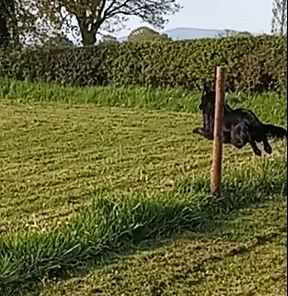
Picture: Max jumping the non-existent fence
Max has seen his flat coated retriever companion, Perkin (pseudonym), walk “through” the fence and they have rolled and played together across the fence line. However, even after three weeks without the fence, it still is a barrier in his mind so he has to jump it.
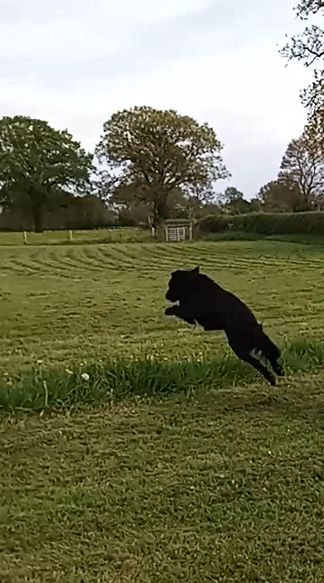
Picture: Max continuing to jump the non-existent fence
It might be interesting to know if other readers of the FCRRN’s newsletters have experience of their dogs retaining a habit that is no longer needed. Is it a habit?
Ukraine: Three flat coated retrievers
Readers might have read about three flat coated retrievers in Ukraine(9) who needed rescuing in May. The happy news is that they have gone to homes in Poland and Germany. The FCRRN do not know the background but we can understand the immense distress of their guardians in Ukraine.
Apparently Izabela Kulczycka, who co-ordinated the rescue and the fund raising, is well known in the UK’s flat coated retriever community. There should be a special place to honour the work of Izabela and other like-minded people who helped on this occasion.
The FCRRN shared the news of the original Facebook posting with some of the supporters of the FCRRN and they all knew about the three flat coated retrievers and they had made donations to the GoFundMe campaign(10). All credit to Izabela for stopping further donations once sufficient funds were available.
Bear and Hooper
In June the FCRRN were notified about two flat coated retrievers who were in the care of the Dogs Trust. One dog, Bear, was in Northern Ireland and the other, Hooper, was in the East Midlands.
The FCRRN contacted several potential adopters from our waiting list. We know the Dogs Trust will not deal with a rescue organisation directly but we hoped to find an individual who could approach the Dogs Trust independently.
Bear was quickly adopted. The FCRRN do not know if Bear was adopted by someone from our list but we do not mind so long as a dog in need has found a good home.
Hooper took longer to find a good home probably because he had some reactive problems towards other dogs. We knew he would be safe with the Dogs Trust because they will not put a healthy dog down and they have good behaviourists. It seems he has now been adopted.
The FCRRN did contact the Black Retriever Cross Rescue about Hooper because we hoped they might have someone on their waiting list who could offer a home. Unfortunately they are struggling to find homes for dogs with even the slightest behaviour problems.
Both the Black Retriever Cross Rescue and the FCRRN receive regular inquiries for “easy dogs” to adopt and some of the inquirers even complete an application form. Some people do not seem to understand that if a dog has to be surrendered then the dog is likely to have some stress-related issues.
Lennox
The FCRRN were contacted in June about Lennox (pseudonym), a male flat coated retriever aged two years. His guardians had developed significant health problems and they were reluctantly contemplating surrendering him to a new home. Lennox is a well-adjusted lad and a potential home was available.
However the guardians decided that Lennox would go to a foster home for a couple of months and then the foster home adopted Lennox. He seems to be settling in comfortably.
Generally the FCRRN do not organise a foster home beyond temporary accommodation for one night or a weekend as part of a surrender and adoption rescue process. The logistics and financial implications are too complex for foster care(1). The Cinnamon Trust (Cinnamon Trust, 2023) offer fostering and respite care as well as day care e.g. walking, company for a dog while the owner attends medical appointments, and we know the Cinnamon Trust are reliable and have high standards of care.
The main issue is that the needs of Lennox are being met and the FCRRN recognise it is emotionally traumatic to have to surrender a dog. It is reassuring to know he has found a good home.
Anatoxin poisoning from cyanobacteria
The FCRRN published a special edition of the newsletter(8) in July 2023 on this subject following the sad news in August 2022 about Cove(4), a two-year-old flat coated retriever, who died due to poisoning from anatoxin-a and related analogues that came from cyanobacteria, formerly known as blue-green algae.
Last year Jan and Paul Egginton from Worcestershire, Cove’s guardians, swiftly raised awareness among dog owners of the dangers posed by cyanobacteria and the Centre for Environment, Fisheries and Aquaculture Science released a précis of the case to Vet Times.
This summer further information has been published in news outlets, the Kennel Club and the Environment Agency as part of an awareness campaign(8).
It must have been very hard for Jan and her family to participate in the awareness campaign. As Cariad Lloyd (Lloyd, 2023) advises in her book, You Are Not Alone, “grief eases and changes and returns, but it never disappears.” We can empathise with their pain at revisiting what happened to Cove.
Editor’s note: I do not know Jan Egginton personally but I am aware of her good work as the secretary and national co-ordinator of the Flat Coated Retriever Society’s rescue, rehousing and welfare scheme. A scheme that seems to function with high standards of integrity, emotional intelligence and competence.
Many of the FCRRN’s supporters know of the potential harm from cyanobacteria but we felt that the current warnings from the Kennel Club and the Environment Agency should be shared. If even one dog can be prevented from harm then it is worth the time spent sending 35 personalised emails and posting the information on our website!
Here is some of the feedback* we have received from our supporters –
• “Thank you for this timely warning.”
• “Many thanks; in addition to the FCRRN’s newsletter, we saw an article in the paper today. The updates are very useful.”
• “Thank you for the updated information relating to blue-green algae and for details of how to recognise its presence. I shall pass this on to other dog owners who may not be aware of the danger to their canine companions.”
• “Many thanks for this…. I am so sorry to hear of Cove’s death .. hugely distressing…”
• “Thank you for the newsletter and detailed information on this pernicious algae. I have fortunately not come across it so far this summer but I am ever vigilant.”
• “Thank you for your email and enclosed newsletter concerning cyanobacteria toxicity. We have to be so careful at this time of year with dogs that love water.”
• “Many thanks; I shall have a good read. Yes, I am always cautious and check watering holes for the girls before they swim. Sky is such a water baby and finding water seems to be one of her great pleasures in life! Even if it is a trough.”
• “Thank you for the information about the anatoxin poisoning. It sounds very scary. There is a pond on White Mountain that looks very toxic.”
• “The article on anatoxin poisoning was very timely and on message. It is cool at the moment and we have had a great deal of rain but I still keep an eye on the areas where the dogs might take a plunge and only allow them to swim in flowing water. Alfie is most at risk as he can be in there before I have seen the water in areas I do not know. I cannot help feeling that if the rain stops and we get warmth then we are in for a challenge as the toxins flourish.”
• “The article about the algae is very interesting. There have been a lot around due to the recent very hot spell of weather.”
• “Thank you for sending the latest FCRRN newsletter; an interesting and informative article as usual. I am always reluctant to let Benson and Harley near lakes and ponds in high summer. Such a shame as they often need to cool off after a hot walk.”
• “Many belated thanks for this information about cyanobacteria. I do find these details most informative and they are always welcome to help keep me up to date.”
*all names are pseudonyms
Editor’s note: many of the FCRRN’s supporters have expressed their condolences to Jan and her family and their thanks to her for sharing the information. The condolences and thanks have been passed to Jan via a mutual personal friend.
Misty and Kane
In August the FCRRN became aware that Misty and Kane (pseudonyms) needed a home. Misty is a female flat coated retriever who will be 10 years young in October 2023. Kane is a male flat coated retriever who is five years young. Due to an unwanted and unavoidable change of circumstances Misty and Kane could not stay in their current home.
Jan Egginton has been leading the search for a home on behalf of the Flat Coated Retriever Society’s rescue, rehousing and welfare scheme. The FCRRN collaborated with Jan and we sent an individualised email to our supporters and to about 20 potential adopters regarding Misty and Kane.
The good news is that Jan Egginton has found a caring home for Misty and Kane together. Also there is a second set of guardians who are happy to be the reserve home in case there is a problem in the first home.
There were offers to take one dog but they need to remain together in their best interests. There were also offers to give them both a home but those homes had other flat coated retrievers and Misty and Kane need to be the only dogs.
Of the other potential adopters on the FCRRN’s waiting list, some people had either adopted elsewhere or bought a puppy, or they wanted a young dog, or they could not adopt two dogs especially a 10 year old, or they did not want a dog with reactivity problems!
We are all hoping that the adoption plan works for everyone especially Misty and Kane.
The FCRRN saw at first hand the high standards of integrity, emotional intelligence and competence of Jan and her colleagues in their rescue, rehousing and welfare scheme.
Blood doning
There are now three rescue flat coated retrievers who have joined the Pet Blood Bank this year i.e. Lucie aged seven who was rescued following being attacked by other dogs; Rose aged six who was rescued weighing only 19kg and with a chronic knee injury that had not been treated; Pip aged three who has developmental eye problems with blindness in one eye and partial sight peripherally in the other eye.
It was a delight to see that Pip was able to keep stationary for the donation bearing in mind his sight problems and his tendency to behave like a mountain goat complete with jumping and heel kicking.
Flat coated retrievers are especially good donors because of their nature (sic) and many are Dog Erythrocyte Antigen (DEA) 1.1 negative which makes them universal donors.
It seems appropriate to reiterate that the Pet Blood Bank are a registered charity (Scottish Charity No: 037745) and they use fundraising to subsidise their costs. The costs charged to vets for blood or platelets cover the funds needed to run the service and the Pet Blood Bank have an agreement with vets who use the donated products that there is no mark-up charge to guardians. See: https://www.petbloodbankuk.org/about-us/our-commitment-to-welfare/
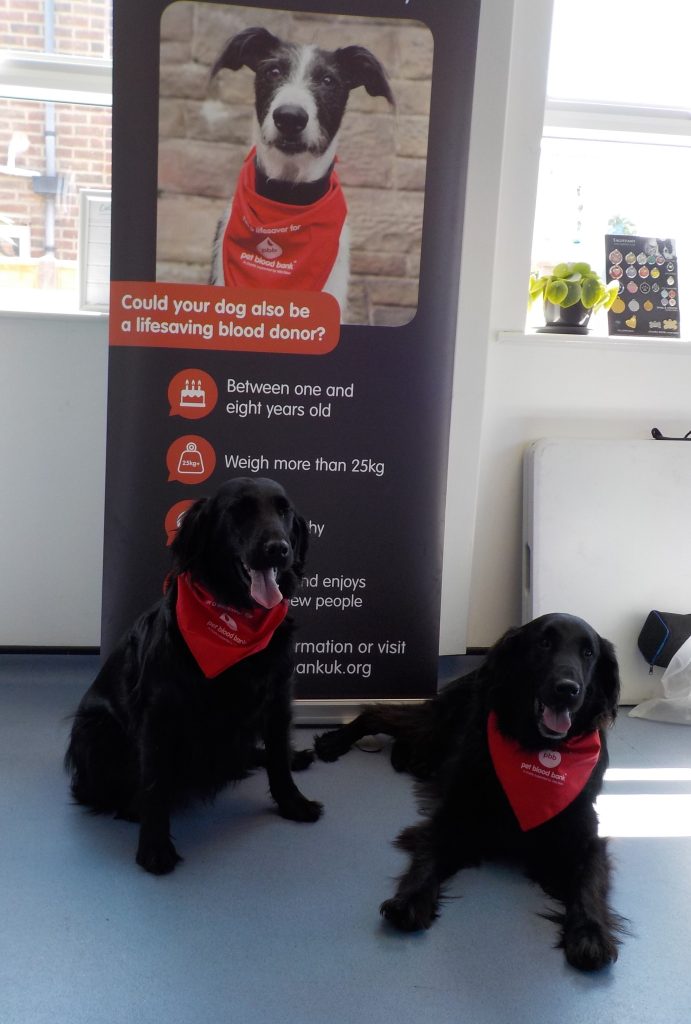
Picture: Lucie (right) and Rose
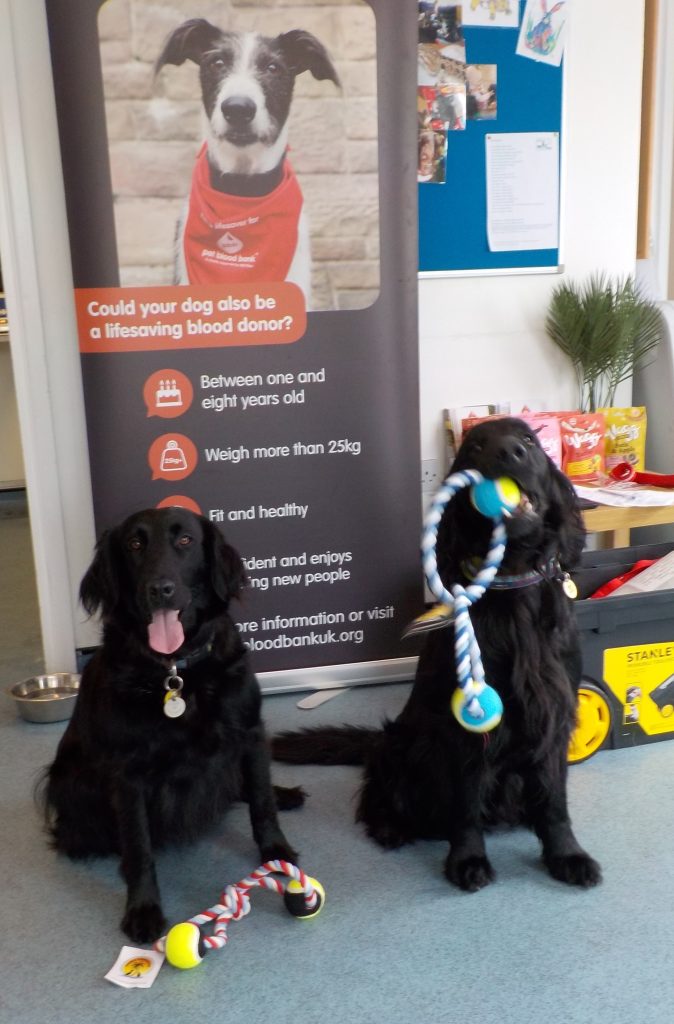
Picture: Pip (right) holding his gift and Rose
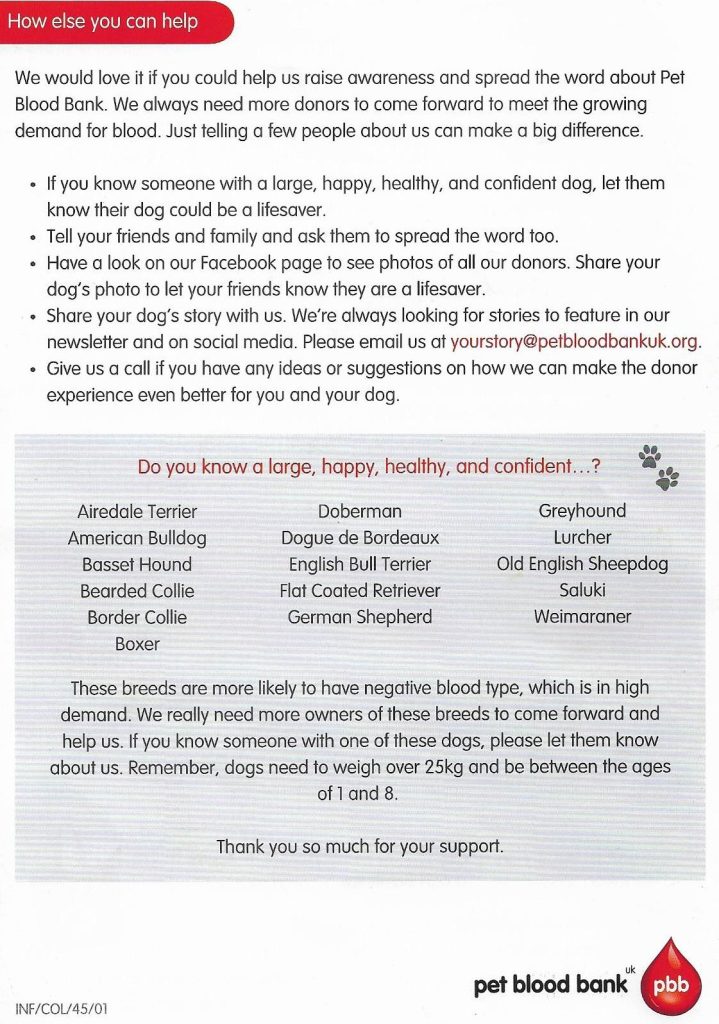
Picture: Pet Blood Bank; extract from the information sheet
Please consider your flat coated retriever as a blood donor; there is further information at:
https://www.petbloodbankuk.org/
https://uk.news.yahoo.com/dog-owners-urged-sign-pets-144515664.html
Canine stem cell therapy
1) Background: The subject of the effectiveness and safety of canine stem cell therapy has been raised by several people in the FCRRN hence the following commentary which is based on the published literature.
2) What are stem cells? Stem cells are cells with the ability to develop into tissues and organs and thereby to heal and grow anew given the right conditions. Stem cells can be obtained from embryonic blood at the time of birth but there are ethical and practical issues which militate against using embryonic stem cells in therapy (Sultana et alia, 2018). Stem cells can be induced via genetic reprogramming but there are ethical concerns about this source (Menon et alia, 2019). The main sources of adult stem cells are the bone marrow, muscles and adipose tissues and many recent research studies have used adult stem cells derived from adipose tissues because of the ease of access and the amount of tissue than can be harvested (Boute, 2022).
The field of regenerative veterinary medicine seeks to use stem cell therapy to treat diseases in veterinary medicine.
3) What happens in stem cell therapy? The donor dog is given a general anaesthetic and adipose tissue is obtained by a surgical incision e.g. below the scapula, in the groin, or into the abdominal cavity. Laparoscopy is being increasingly used due to its minimal invasiveness hence it offers greater safety and a higher yield of stem cells (Buote, 2022). In the laboratory the adipose tissue is broken up by mechanical disruption, e.g. centrifugation, and enzyme digestion, e.g. collagenase, with the aim of preserving the stem cells (Prišlin et alia, 2022). Then the stem cells are cultured to make specific types of cell, e.g. cardiac, intestinal, liver, dental pulp, muscle, nerve, osteocyte, and blood, and preserved by freezing (Quimby et alia, 2019).
Subsequently, the cultured cells are transplanted into the recipient animal using a clinically appropriate anaesthetic via one of several routes including into a joint (intra-articular), into a vein (intravenous), or using acupuncture points (Prišlin et alia, 2022).
The transplantation of the cultured stem cells is classified by the relationship between the donor and recipient (Voga et alia, 2020).
In an autologous transplantation, the recipient receives their own cells i.e. Lucie, flat coated retriever, donates the adipose tissue and she is the recipient of the cultured cells.
In an allogeneic transplantation, the recipient receives cells from an animal of the same species i.e. Rose, flat coated retriever, receives cultured cells donated by Lucie.
In a xenogeneic transplantation, the recipient receives cultured cells from a different species i.e. Jess, feline, receives cultured cells donated by Lucie.
Most research studies have investigated the safety and effectiveness of stem cell therapy in autologous transplantation (Kang et alia, 2020). Autologous transplantations are preferred in veterinary studies because the cells are immunologically compatible and there is no donor harvesting which is important ethically (Brondeel et alia, 2021).
4) What is the research basis for stem cell therapy? The extensive research in the past thirty years indicates that the cultured stem cells have the ability to migrate to damaged tissues (homing) and the potential to repair defects, to grow new tissues, to generate blood vessels that bring oxygen and other nutrition to the new tissues (angiogenesis), to interact with the immune system to reduce inflammation (immunomodulation), to promote a range of organ specific growth factors, to send signalling molecules, inter alia (Kang et alia, 2020; Prišlin et alia, 2022; Voga et alia, 2020).
5) What are the uses of stem cell therapy? Stem cell therapy research has been carried out in nearly every system in the canine body to try and treat diseases e.g. specifically in these systems – cardiovascular, gastrointestinal (Isidori et alia, 2022) including hepatology and orodental, musculoskeletal/locomotor including soft tissue injuries (Carr, 2023), neurology, renal (Quimby et alia, 2019), wound healing in ophthalmology and the skin, and also for cancers especially in haematology (Kang et alia, 2020).
The systems where the most progress has been made in gathering research evidence about the effectiveness and safety of stem cell therapy are the musculoskeletal system for the treatment of osteoarthritis and tendon injuries and the neurology system for spinal cord injuries (Brondeel et alia, 2021; Kang et alia, 2020; Prišlin et alia, 2022; Voga et alia, 2022).
However the common themes in all the recent reviews of the effectiveness and safety of stem cell therapy are that there are promising results but they are inconclusive when evaluating the results of the stem cell therapy. There are significant variations in the dogs and definitions of disease, controls (sometimes used; sometimes not used), treatment regimens, and outcome indicators including short and long-term safety. There is a need for randomised clinical trials with subjects and controls, explicitly-described stem cell characteristics, treatment protocols including dosages, frequency and routes of administration, and measurements of standardised outcomes by observers who do not know whether the dogs are subjects or controls, inter alia (Brondeel et alia, 2021; Isidori et alia, 2022; Kang et alia, 2020; Prišlin et alia, 2022; Voga et alia, 2020).
6) What are the issues around safety in stem cell therapy? There are many potential benefits from stem cell therapy but the safety issues need to be considered too. For examples, donor selection criteria; the collection of adipose tissue from the donor involves a general anaesthetic and surgery; aseptic techniques during the stem cell extraction from the adipose tissue and their preservation; culture sterility including the exclusion of infections agents (viruses, bacteria, mycoplasma, endotoxins, inter alia); cryopreservation without loss of phenotype or differentiation potential (Quimby et alia, 2019); administration of the stem cells to the recipient and the risks from the anaesthetic, from haemorrhage, infection and allergic reactions; stem cell survival and distribution; worsening of pre-existing symptoms in the immediate-term and long-term; immediate and long-term side effects including immune responses especially rejection, tumour development, and ectopic tissue formation (Brondeel et alia, 2021; Boute, 2022; Isidori et alia, 2022; Kang et alia, 2020; Prišlin et alia, 2022; Voga et alia, 2020).
7) Conclusions
My qualifications are in human animal medicine and I am aware of the standards used in human animal stem cell therapy (National Institute for Biological Standards and Control, 2023). It came as some surprise and disappointment to discover that there are no standards for canine stem cell services produced by the UK government’s Veterinary Medicines Directorate.
There are standards for equine stem cell services and an equine stem cell centre authorisation (ESCCA) is required, “to collect, store, process, produce and administer equine stem cells,” (Veterinary Medicines Directorate, 2023).
The Royal Veterinary College is one of the few UK centres with the ESCCA for equine stem cell therapy and the Stem Cell Centre of the Royal Veterinary College applies the same standards for their canine stem cell therapy activities as the standards they apply for their equine stem cell activities (Royal Veterinary College, 2023).
Similarly for canines in the USA there are no Federal Drugs Agency-approved stem cell therapies (Boute, 2022). Guidelines have been produced for the safe use of stem cell therapy in the European Union, USA and Korea (Kang et alia, 2020; Voga et alia, 2020). The European Medicines Agency (2022) have recently issued a concept paper about the assay, effectiveness and safety of stem cell (cell-based) products.
In my opinion, there is a need for the UK veterinary community including the Veterinary Medicines Directorate, veterinary regulator, veterinary professional bodies, universities and practitioners to come together and agree standards for canine stem cell services in the UK.
If one of my flat coated retrievers is in potential need of stem cell therapy then I would firstly discuss the subject with my veterinary physician (primary care veterinarian) and then I would discuss the subject with the Stem Cell Centre of the Royal Veterinary College (secondary opinion) and then I would discuss everything with a tertiary source e.g. a part-time veterinary physician who does independent consultancy work.
I would assess how carefully these three professionals considered the needs of my flat coated retriever and listened to me before I reassessed the published literature and then I would develop a plan which would, hopefully, be jointly agreed with at least two of these professionals.
And finally
We wish you and your flat coated retrievers and your other companions well for the autumn.
Please could you remember the Flat Coated Retriever Rescue Network if, via any route, you learn that a surrender or adoption is being considered?
Dr. Iain J. Robbé
On behalf of the Flat Coated Retriever Rescue Network (FCRRN)
Email: walesandwm@gmail.com
http://www.iainrobbe.com/fcrrn_09/
“Rescues R Us”
Experts: none of the FCRRN is acting in the capacity of an expert; each contributor is offering their advice based on accessible evidence. If you are concerned about any subject in the newsletters then you should consult a veterinary professional, legal professional or other professional.
© 2023 Flat Coated Retriever Rescue Network
(1) http://www.iainrobbe.com/fcrrn_01/
(2) http://www.iainrobbe.com/fcrrn_02/
(3) http://www.iainrobbe.com/fcrrn_03/
(4) http://www.iainrobbe.com/fcrrn_04/
(5) http://www.iainrobbe.com/fcrrn_05/
(6) http://www.iainrobbe.com/fcrrn_06/
(7) http://www.iainrobbe.com/fcrrn_07/
(8) http://www.iainrobbe.com/fcrrn_08/
(9) https://m.facebook.com/story.php?story_fbid=pfbid02SKb48SP7eFeqRsqePau3mj69ssyFEMFS4bnGNJe687YVjGZ9kfuwq67avUgQtha3l&id=100064240292972&sfnsn=scwspmo
(10) https://www.gofundme.com/f/3-flatcoated-retrievers-rescue-from-ukraine
Brondeel, C., et alia. (2021). Mesenchymal Stem Cell Therapy in Canine Osteoarthritis Research: “Experientia Docet” (Experience Will Teach Us). https://doi.org/10.3389/fvets.2021.668881
Buote, N. J. (2022). Laparoscopic Adipose-derived Stem Cell Harvest Technique with Bipolar Sealing Device: Outcome in 12 Dogs. https://doi.org/10.1002/vms3.816
Carr, B. J. (2023). Regenerative Medicine and Rehabilitation Therapy in the Canine.
https://doi.org/10.1016/j.cvsm.2023.02.011
Cinnamon Trust. (2023). https://cinnamon.org.uk/cinnamon-trust/
European Medicines Agency. (2022). https://www.ema.europa.eu/en/documents/scientific-guideline/concept-paper-development-data-requirements-potency-tests-cell-based-therapy-products-relation_en.pdf
Isidori, M., et alia. (2022). Nonpharmacological Treatment Strategies for the Management of Canine Chronic Inflammatory Enteropathy – A Narrative Review.
https://doi.org/10.3390/vetsci9020037
Kang, M. H., et alia. (2020). Challenges of Stem Cell Therapies in Companion Animal Practice. https://doi.org/10.4142/jvs.2020.21.e42
Lloyd, C. (2023) You Are Not Alone. London: Bloomsbury Tonic.
Menon, D. V., et alia. (2019). The Road Less Travelled: The Efficacy of Canine Pluripotent Stem Cells. https://doi.org/10.1016/j.yexcr.2019.01.025
National Institute for Biological Standards and Control (NIBSC). (2023). https://www.nibsc.org/
Sub-heading: UK Stem Cell Bank
Packer, R. M. A., et alia. (2023). Is UK Puppy Purchasing Suffering a Long COVID Effect? Ongoing Negative Impacts of the COVID-19 Pandemic upon Puppy Purchase Motivations and Behaviours in 2021. https://doi.org/10.3390/ani13132186
Prišlin, M., et alia. (2022). An Outstanding Role of Adipose Tissue in Canine Stem Cell Therapy. https://doi.org/10.3390/ani12091088
Quimby, J. M., et alia. (2019). Stem Cell Therapy. https://doi.org/10.1016/j.cvsm.2018.10.001
Royal Veterinary College. (2023).
https://www.rvc.ac.uk/veterinary-services/stem-cell-centre/therapies-for-dogs
Sultana, T., et alia. (2018). Current Status of Canine Umbilical Cord Blood-Derived Mesenchymal Stem Cells in Veterinary Medicine. https://doi.org/10.1155/2018/8329174
Veterinary Medicines Directorate. (2023). https://www.gov.uk/government/organisations/veterinary-medicines-directorate
Sub-heading:
Voga M., et alia. (2020). Stem Cells in Veterinary Medicine – Current State and Treatment Options. https://doi.org/10.3389/fvets.2020.00278
Voga M., et alia. (2022). Articular Cartilage Regeneration in Veterinary Medicine.
https:/dx.doi.org/10.1007/5584_2022_717
